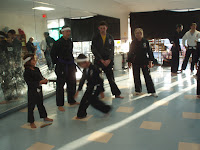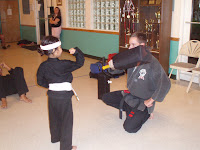I hope that some of the hints that I’ve mentioned in the previous posts have come in handy and that you and your students are having an adventurous time in the dojo. This post will be an easy read.
I am going to make a list of drills (I call them games) you can put into different portions of the training. Try one or all of them and let me know how they work for you. Some of these drills were used when I was a kyu, in an adult class. I will mark those with an asterisk.
Sh
 ark and Eagle*
ark and Eagle* Description of Drill: Place one student in a ground fighting position and one in a fighting stance. Have the standing student try to tag the ground fighting student with a kick or a punch in the belly or the head. Have the ground fighting student use his guard po
 sition, movement on the ground, and kicking / grabbing to defend.
sition, movement on the ground, and kicking / grabbing to defend.When to use it: This one works at the beginning, middle, and end of class. There is no end to the uses of this game.
Other details of interest: Everyone loves this game, even adults. This drill really improves the student’s ability to move in the ground fighting position and the attack from the ground.
Spin and Find the Knife*
 Description of Drill: Get a rubber knife. (This also works with a wooden gun and even karate weapons.) Have all the kids stand in a circle and explain how to play: One child will go into the middle of the circle and start spinning around “helicopter” style. While he is spinning,
Description of Drill: Get a rubber knife. (This also works with a wooden gun and even karate weapons.) Have all the kids stand in a circle and explain how to play: One child will go into the middle of the circle and start spinning around “helicopter” style. While he is spinning, you drop the knife somewhere in the circle. After he is sufficiently dizzy, have him stop and try to find the knife, pick it up by the handle, and take his guard position. Let everyone have a turn.
you drop the knife somewhere in the circle. After he is sufficiently dizzy, have him stop and try to find the knife, pick it up by the handle, and take his guard position. Let everyone have a turn.When to use it: Good at the end of the day, or after working knife techniques. It really opens the door for discussion on the danger of weapons.
Other details of interest: This is a popular game. As an adult kyu, we played this game to simulate what it feels like to have your ears boxed. That came in handy later when I did have my ears boxed. What a case of vertigo!!
Blocker
Description of Drill: The blocker is a staple when teaching blocking systems to anyon
 e under the age of 8. After the repetition of the blocking system, use the blocker to hit the children. I hit them, first in the order that I worked the blocks and then randomly, strictly for the laughter. All ages like it, but under the age of 8 it is the ‘reward’ for staying focused.
e under the age of 8. After the repetition of the blocking system, use the blocker to hit the children. I hit them, first in the order that I worked the blocks and then randomly, strictly for the laughter. All ages like it, but under the age of 8 it is the ‘reward’ for staying focused.When to use it: Obviously, this drill fits best after working repetition on blocking, whether at the beginning, middle, or end of class.
Other details of interest: Although the blocker wasn’t around when I was a kyu, it is a daily tool in my teaching bag. I try to bring it to every class and miss it when I forget. Even though this photo shows one student and teacher. More often, I am using a blocker on 10 or more kids at the same time. I am running up and down the rows and they are blocking and laughing. Everyone is getting stronger.
Blocker vs. Blocker 
Description of Drill: Hand each child a blocker and let them strike at each other. Before you let them start, explain that the soft part of the blocker is the hitting part. If they hit with the handle it will hurt them both. (Inevitably, someone will catch their finger in the clashing handles, but at least you warned them.)
When to use it: This game fits in the middle and at the end of class. It is a great stress reliever if you have been focusing on technology for a long period. Or, it is a treat instead of sparring at the end of class.
Other details of interest: The kids call this playing “star wars”. Try it once and watch their excitement. Let me know if your kids love it as much as mine.

Description of Drill: Hand each child a blocker and let them strike at each other. Before you let them start, explain that the soft part of the blocker is the hitting part. If they hit with the handle it will hurt them both. (Inevitably, someone will catch their finger in the clashing handles, but at least you warned them.)
When to use it: This game fits in the middle and at the end of class. It is a great stress reliever if you have been focusing on technology for a long period. Or, it is a treat instead of sparring at the end of class.
Other details of interest: The kids call this playing “star wars”. Try it once and watch their excitement. Let me know if your kids love it as much as mine.
Double-Ended Blockers
 Description of Drill: Each participant has a double ended blocker and they block and strike each other for an allotted period of time. I keep my matches under 45 seconds to keep the injuries down.
Description of Drill: Each participant has a double ended blocker and they block and strike each other for an allotted period of time. I keep my matches under 45 seconds to keep the injuries down.When to use it: It is an end of the day game. I use it about 4 times a year as a special event.
Other details of interest: In this picture, Cody and Kyle are having some fun, don't you think?This game requires 4 blockers and 2 couplers. This is about a $50 or $75 investment. (I have tried making my own out of PVC and padding, but they don’t hold up, they are too heavy, and they don’t work very well.
Jump rope
Description of Drill: The jump rope I am referring to is about 10 feet long. Hook one end to a chair and hold the other end. Have the participants earn their jump rope turn by answering a karate question or showing a karate skill. I give them three choices of how to p
 ass through the rope:
ass through the rope:1. Just run through the turning rope.
2. Just jump rope and run out when you have jumped 5 or more times. (That is up to the teacher. Make sure everyone is allowed to jump the same number of times).
3. Run in and jump rope (5 times). Run out when you are done.
When to use it: This game fits in all parts of training. I use it almost exclusively at the end of class. I use the game to review history and philosophy of karate by having the students answer questions in order to
 get their turn.
get their turn.Other details of interest: This drill is as popular as any of the drills I use. It is, as all my drills are, a way to vary the repetition of training. It also builds timing, speed, and agility in movement. The first time I ever saw anyone using the jump rope was while teaching with Sensei Nick Brown over 20 years ago. I have tweaked it a little over the years, but have been using consistently throughout my teaching.
One quick note: If your class is oversized (30 kids) it might take 25 or 30 minutes to do some of these drills. Therefore, I recommend that you divide the children into groups of 10. One group can work stretch, exercise, basics etc. One group can work technology. One group can “play” with one of these drills. If you try to do 30 children in the jump rope game or the spin and find the knife game or the blocker vs. blocker game, the kids have too much down time and it isn’t good use of the time.
Use the drills and let me know if you have questions, failures, or successes.
Oos,
Md
Oos,
Md

No comments:
Post a Comment
Talk to me.